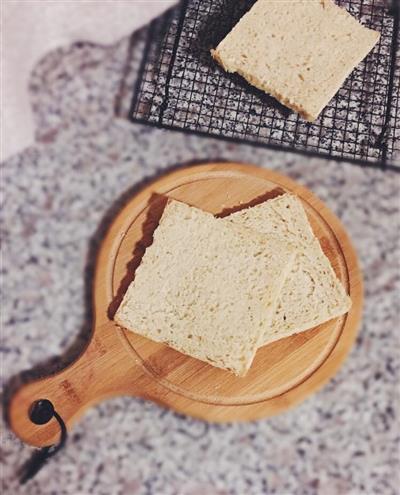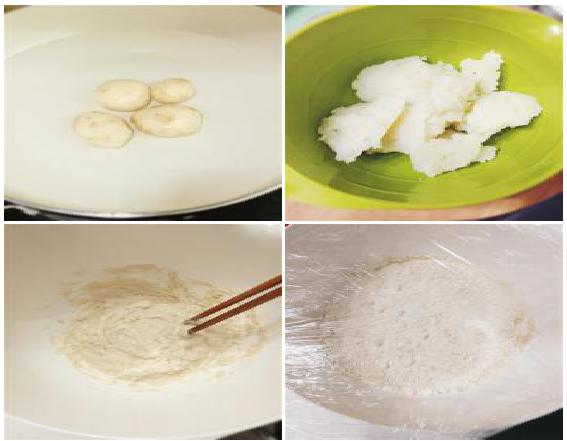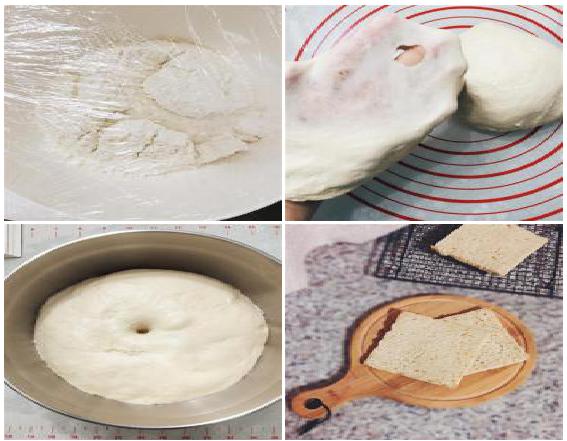Sponge yeast method

I bought a lot of books on how to make bread, and I thought that toast could be so diverse, and it couldn't be better for me, who likes to eat all kinds of sandwiches, although some of them take longer, and the steps are very different from the usual ones, but they still give me a lot of surprises.This toast is from the bread bible, the original toast is 22 grams, you can also use the normal 450 grams, I use a water cube plus a small submarine.This bread is made with potatoes to make it tighter and more flavorful.
WHAT YOU NEED
Ingredients
Sponge yeast: in moderation170 grams of potatoes113 grams of wheat flourWater for cooking potatoes (cooled to room temperature) 99 grams21 grams of honey1.2 grams of active dry yeastFlour mixture and dough: moderate179 grams of wheat flour14 grams of milk powder3 grams of active dry yeast17 grams of butter128 grams of mashed potatoes6.6 grams of salt
How TO MADE Sponge yeast method
Steps 1 to 4

1. Put the washed potatoes (without peeling) in the pot, add the water that has not been used on the potatoes, and cook for 20 to 30 minutes until the potatoes are soft.
2. The dry water is used as a backup, and the water used to cook the potatoes is used to dry the potatoes until they are warm.
3. Peel the potatoes, crush them and make a smooth potato paste, taking 128 grams as a reserve.
4. In a large bowl, mix flour, boiled potato water, honey and yeast, stir until smooth, at this point the dough should be even and sticky.
Steps 5 to 8

5. In a medium-sized bowl, mix flour, milk powder and yeast.
6. The mixture is then sprinkled on the yeast head (on the dough in the previous step), wrapped tightly in a bowl with a preservative film, and fermented at room temperature for 1-4 hours.
7. I've packed two layers.
8. During this time, the sponge head produces bubbles, and the bubbles emerge from the flour blanket, which is a good phenomenon.
9. This is about an hour of fermentation, and I've been fermenting for about three hours today.
10. Depending on your circumstances, you can keep it at room temperature for an hour and then refrigerate it for 8 to 24 hours.
11. In a well-fermented dough, add salt, softened butter and potato paste, stir with a wooden spoon or by hand and start with the dough.
12. At first, if the dough is very sticky, it can be left for 20 minutes and then rubbed.
13. Stir until the dough is very smooth (full stage).
14. It is then placed in a deep container, wrapped in a preservative film, and fermented for one to two hours at a temperature of 24-27 degrees, up to twice the size.
15. Remove the dough (with a scraper or a knife) and gently press the dough to grow a square shape. Since the dough is full of air and elastic, the bubbles in it should be preserved as much as possible when pressing.
16. Fold the dough twice in a folding envelope, then put it in a bowl and let it stand for 1.5-2 hours, until it doubles in volume, at which point poke a hole, and the recess will slowly bounce back.
17. Remove the dough, place the dough shape in the mold, cover the mold, and let it stand for 1.5-2 hours.
18. Preheat the oven to 246 degrees, rub a layer of honey on the surface of the dough, bake for 5 minutes, then turn to 191 degrees, bake 20-25 degrees, you can add tin paper in the middle.
19. No, I've always liked to eat it after it's cooked.
20. Soft, simple texture, and an unstoppable flavor.
Handy cooking tips
For quick yeast powder and active dry yeast: quick yeast powder does not need to be dissolved and soaked in water, active dry yeast has a high content of dead yeast cells and is widely used for making pizza and bread.If there is a small partner of fast yeast powder, 0.8g and 2.4g can be used respectively.The other side of the steps is more complicated, and I've simplified it appropriately.(ω???) Is it really lazy?
REACTION RECIPES
- Whole wheat bread
- Bread from the pine trees
- Bread in the shape of a ring
- Onion bread
- Chocolate bread
- Onion cheese, salted bread, and an unforgettable cocoa.
- Yoghurt toast
- Peeled walnut and date bread
- Crab bread
- A small meal package with a bread maker
- Super hot cheese bread
- Homemade black pepper crispy sausage
- What a puppy bread.
- Super soft milk bread
- Hong Kong-style milk steak - rich in milk flavor and a classic of bread
MOST POPULAR RECIPES
- Chocolate cake with strawberry cream
- Durian mousse cake
- Barbie doll cake
- Birthday cake
- Small cake with cream squares
- Matcha tiramisu
- Love from Fennel Snow
- Thanksgiving cake
- Blueberry and cheese brownies
- Coffee and cakes
- Beef on wheels
- Banana pound cake
- Basic raw pound cake
- Cream and fruit cake cups
- English apple pie
RECIPE TAGS:
-
Sponge yeast: in moderation170 grams of potatoes113 grams of wheat flourWater for cooking potatoes (cooled to room temperature) 99 grams21 grams of honey1.2 grams of active dry yeastFlour mixture and dough: moderate179 grams of wheat flour14 grams of milk powder3 grams of active dry yeast17 grams of butter128 grams of mashed potatoes6.6 grams of salt

 DESSERTS
DESSERTS  BAKING
BAKING  MAIN DISHES
MAIN DISHES  SNACKS
SNACKS  CHINESE FOOD
CHINESE FOOD  HOME
HOME






